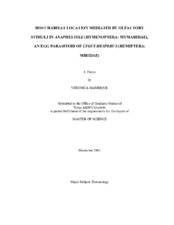Host habitat location mediated by olfactory stimuli in anaphes iole (hymenoptera: mymaridae), an egg parasitoid of lygus hesperus (hemiptera: miridae)
Abstract
Lygus hesperus is an important pest on different crops including cotton and alfalfa in the western U.S. Anaphes iole is a common parasitoid of Lygus spp. eggs in the U.S. and has potential as a biological control agent against L. hesperus in different crops. Its foraging behavior has been studied to a limited extent, but it is unknown whether A. iole females rely on plant volatiles to locate host habitats. L. hesperus feeding and oviposition are known to induce emission of plant volatiles in cotton and maize, but no studies have addressed the role of plant volatiles in the host searching behavior of A. iole. The objectives of this study were to evaluate the attraction of A. iole females toward volatiles derived from L. hesperus habitats and flight response of A. iole females toward cotton plants harboring L. hesperus eggs or treated with methyl jasmonate. Results from olfactometry bioassays showed that female wasps were attracted to odors emanating from different plant-L. hesperus complexes and from adult L. hesperus, while plants damaged by non-hosts or mechanically-damaged were not attractive. These findings suggested that A. iole females use specific plant volatiles released following L. hesperus feeding and oviposition to locate host habitats. In addition, in flight chamber tests A. iole females discriminated between cotton plants with moderate (41 eggs) and high (98 eggs) levels of L. hesperus infestations relative to uninfested plants, but not between plants with low (7 eggs) infestations compared to uninfested plants. In larger scale experiments conducted in the greenhouse, female wasps responded to L. hesperus-infested plants but not to methyl jasmonate-treated plants under similar conditions. Overall, results from this study revealed that A. iole females employ volatile signals to locate its host’s habitat and that they are attracted to plants damaged by L. hesperus feeding and oviposition. However, further research should seek to identify the chemical elicitors involved in the release of plant volatiles attractive to A. iole females.
Citation
Manrique, Veronica (2003). Host habitat location mediated by olfactory stimuli in anaphes iole (hymenoptera: mymaridae), an egg parasitoid of lygus hesperus (hemiptera: miridae). Master's thesis, Texas A&M University. Texas A&M University. Available electronically from https : / /hdl .handle .net /1969 .1 /1597.


